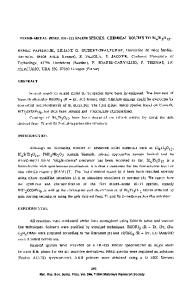Characterization of Epitaxial Bi-Layer-Structured Bi 5 Ti 3 FeO 15 (m = 4) and Bi 4 Ti 3 O 12 -Bi 5 Ti 3 FeO 15 (m = 3-4
- PDF / 972,891 Bytes
- 6 Pages / 612 x 792 pts (letter) Page_size
- 73 Downloads / 329 Views
1034-K01-05
Characterization of Epitaxial Bi-Layer-Structured Bi5Ti3FeO15 (m = 4) and Bi4Ti3O12Bi5Ti3FeO15 (m = 3-4) Natural-Superlattice-Structured Multiferroic Thin Films Prepared by Pulsed Laser deposition Seiji Nakashima, Yoshitaka Nakamura, and Masanori Okuyama Division of Advanced Electronics and Optical Science, Department of Systems Innovation, Graduate school of Engineering Science, Osaka University, 1-3 Machikaneyama-cho, Toyonaka, 560-8531, Japan
ABSTRACT Bi-layer-structured mutiferroic Bi5Ti3FeO15 (BTFO15) (m = 4) and natural-superlatticestructured Bi4Ti3O12- Bi5Ti3FeO15 (BIT-BTFO15) (m = 3-4) thin films have been prepared on (001) and (110) oriented SrTiO3 (STO) single crystal substrates by using pulsed laser deposition. X-ray diffraction patterns of these thin films on (001) STO single crystals shows the obtained thin films were (00l)-oriented layer-perovskite single phase, and BIT-BTFO15 (m = 3-4) naturalsuperlattice-structure has also been obtained. On (110) STO single crystal, layer perovskite (11l) oriented thin films have also been obtained. For characterizing ferroelectric properties, these thin films have been prepared on (001) and (110) oriented La-doped (3.73 wt%) STO single crystal substrates. From ferroelectric D-E hysteresis loops measurements, BTFO15 (m = 4) and BITBTFO (m = 3-4) thin films on (110) La-doped STO single crystals shows good ferroelectric hysteresis loops and their double remanent polarizations (2Pr) were 47 µC/cm2 and 44 µC/cm2, respectively. However, these thin films on (001) La-doped STO single crystals do not show ferroelectric characteristics. INTRODUCTION Multiferroic materials such as YMnO3, BiFeO3 (BFO), and BFO-BaTiO3 (solid solution) have been attracted considerable interest because they exhibit ferroelectricity, ferromagnetism, and ferroelasticity simultaneously. In recent year, new types of mutiferroic materials such as TbMnO3 and LuFe2O4 have been well investigated [1, 2]. However, there is as yet no report on realizing the coexistence of ferroelectricity, ferromagnetism, and a large ME effect at room temperature (RT) due to the incompatibility of ferroelectricity and ferromagnetism [3]. In conventional ABO3-type perovskite ferroelectrics, the B site ion with “d0-ness” condition takes an important role for stabilizing a noncentrosymmetric distorted structure. On the other hand, for magnetic ferroelectrics, the magnetic transition metal ions which have d electrons are located on the B site. Therefore, the Bi3+ or Pb2+ ion located on the A site, which the 6s2 lone pair has strong covalent characteristics of the Bi (Pb) – O bond is necessary. BiFeO3 is one of the well investigated materials in ceramic and thin film forms. It has been already reported that polycrystalline BFO thin films on Pt/TiO2/SiO2/Si substrates show a large spontaneous polarization of 166 µC/cm2 [4]. On the other hand, the BFO has an antiparallel arrangement of the spins in the neighboring iron atoms that gives a G-type antiferromagnetic ordering, and also shows a weak ferromagnetic ordering d
Data Loading...











